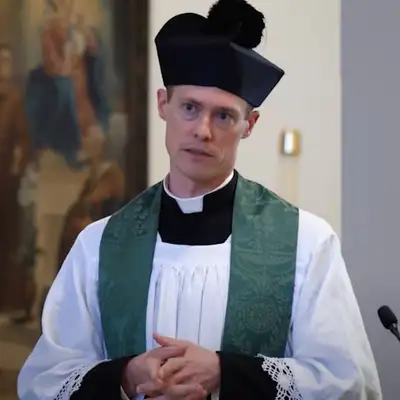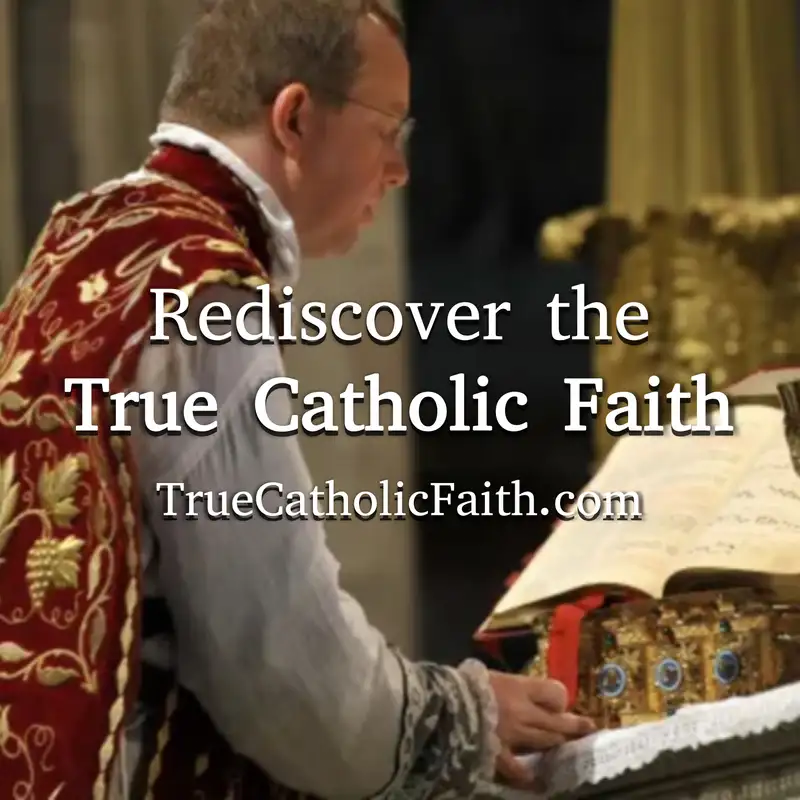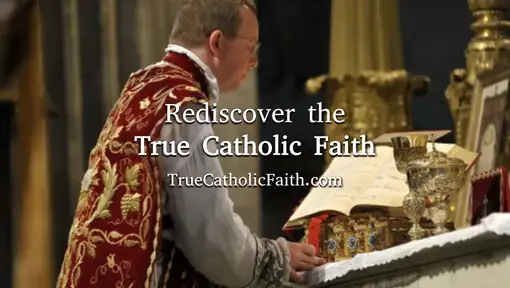What Is a Traditional Catholic? - Fr. Michael DeSaye 09-18-23
Download MP3Summary
Fr. Michael DeSaye presents a detailed exploration of what it means to be a traditional Catholic in the post-Vatican II era, particularly focusing on the liturgical and doctrinal changes that have shaped the contemporary Church crisis. He begins by describing the drastic transformation of the Catholic Mass after Vatican II—from the Latin Tridentine Mass, celebrated quietly with Gregorian chant and the priest facing the altar, to the vernacular Novus Ordo Mass with a priest facing the people and contemporary music. This shift caused shock and resistance among many Catholics, leading to the emergence of the traditional Catholic movement, which primarily sought to preserve the traditional Latin Mass and uphold traditional Catholic morals, modesty, frequent confession, and often homeschooling.
Fr. DeSaye categorizes traditional Catholics into three main groups:
- the Society of St. Pius X (SSPX), which operates independently of the Vatican and rejects collaboration with clergy loyal to Pope Francis (Bergoglio);
- the Fraternity of St. Peter (FSSP) and similar groups that celebrate the traditional Mass within the Church’s juridical structure and remain obedient to the Vatican;
- and diocesan priests inspired by Pope Benedict XVI’s Summorum Pontificum (2007), who secretly or irregularly celebrate the traditional Latin Mass while officially serving the Novus Ordo. These diocesan priests often harbor doubts about the legitimacy of Pope Francis and even entertain the idea that Benedict XVI might have been the last true pope, a position known as Benevacantism.
Fr. DeSaye argues that attacking Pope Francis personally, even if he were proven a heretic, would not resolve the Church’s crisis, which is rooted deeper in the post-Vatican II changes and the alleged invalidity of the popes since John XXIII. According to Fr. DeSaye, these popes and their reforms represent a break from authentic Catholicism, introducing a new religion with altered doctrines, worship, and morality. Since the Church cannot defect from the truth given by Christ, those occupying the papal office since Vatican II cannot be true popes.
Consequently, Fr. DeSaye advocates for Sedevacantism—the belief that the papal seat has been vacant since Vatican II—as the only genuinely Catholic stance today. It emphasizes that this is not an extremist or optional opinion but a requirement of the Catholic faith. To accept the post-Vatican II popes as legitimate would mean denying the Church’s infallibility and indefectibility, thereby endangering one’s faith and salvation. Fr. DeSaye concludes by urging Catholics to recognize this reality and reject the post-Vatican II papacy to preserve the integrity of their faith.
Highlights
- Vatican II brought a radical change to the Mass, shifting from the traditional Latin Mass to the vernacular Novus Ordo Mass, causing shock and resistance among many Catholics.
- Traditional Catholics are often identified by their preference for the Latin Mass, modest dress, frequent confession, and adherence to traditional moral teachings, with some even homeschooling their children.
- There are three main groups of traditional Catholics: SSPX (outside Vatican structures), FSSP and similar groups (within Vatican structures), and diocesan priests inspired by Summorum Pontificum who celebrate the Latin Mass irregularly.
- Some traditional Catholics and priests harbor doubts about the legitimacy of Pope Francis and the post-Vatican II popes, with a faction known as Benevacantists considering Benedict XVI the last true pope.
- The crisis in the Church is not just about the personal heresy of Pope Francis, but the broader rupture caused by Vatican II’s reforms and the new religion imposed on the Church.
- Sedevacantism, the belief that the papal seat has been vacant since Vatican II, is presented as the only truly Catholic response to the crisis, not a fringe ideology.
- Accepting the post-Vatican II popes as legitimate undermines the Catholic doctrines of infallibility and indefectibility, risking the salvation of the faithful.
Key Insights
- Vatican II’s Liturgical Reform as a Catalyst for Crisis: The transition from the Latin Tridentine Mass to the Novus Ordo Mass was not merely a change in language or music but a profound liturgical and theological rupture that unsettled the faithful and sparked a traditionalist reaction. This shift symbolizes the broader post-conciliar changes that many see as a departure from authentic Catholicism.
- Diversity Within Traditional Catholicism: The traditionalist movement is not monolithic but divided into distinct groups with varying relationships to the Vatican. SSPX’s rejection of Vatican authority contrasts sharply with FSSP’s obedience, while diocesan priests inspired by Summorum Pontificum occupy a liminal space, quietly preserving tradition within the official Church structure.
- The Role of Summorum Pontificum in the Resurgence of the Latin Mass: Pope Benedict XVI’s 2007 letter theoretically allowed the traditional Mass to be celebrated without bishop approval, sparking a quiet revival among diocesan priests. However, episcopal resistance often forced these priests to celebrate the Latin Mass covertly, highlighting ongoing tensions within Church authority.
- The Emergence of Benevacantism Among Traditional Catholics: Some traditional clergy and laity have begun to question the legitimacy of Pope Francis and even earlier post-Vatican II popes, considering Benedict XVI the last true pope. This reflects a growing crisis of papal authority and signals dissatisfaction with the current pontificate’s direction.
- Critique of Personal Heresy Focus: Fr. DeSaye argues that focusing solely on Pope Francis’s alleged personal heresy misses the root cause of the crisis—the post-Vatican II reforms themselves and the invalidity of the subsequent papacies. This suggests that the problem is systemic rather than individual.
- Sedevacantism as the Only Faithful Response: The belief that the papal seat has been vacant since Vatican II is framed as a theological necessity grounded in the doctrines of infallibility and indefectibility. The acceptance of Vatican II popes as legitimate contradicts these doctrines and threatens salvation, making Sedevacantism a matter of faith rather than opinion.
- The Crisis as a Consequence of a New Religion: Fr. DeSaye posits that the post-Vatican II Church introduced a substantially new religion with altered doctrines and morality, incompatible with the original Catholic faith. This radical claim challenges the legitimacy of the current Church hierarchy and calls for a radical reassessment of Catholic identity.
Detailed Analysis
The homily delves deeply into the liturgical and ecclesiological crisis facing the Catholic Church since Vatican II, emphasizing that the changes were not superficial but represented a fundamental break with tradition. The transformation of the Mass is emblematic of a broader crisis, with the traditional Latin Mass seen as not merely a preference but the expression of authentic Catholic worship and doctrine. The resistance to the Novus Ordo Mass reflects a deeper rejection of the theological and moral shifts that accompanied it.
The identification of three distinct groups within the traditionalist movement elucidates the complexity of the phenomenon. The SSPX’s outright rejection of Vatican authority represents a radical stance, while groups like the FSSP attempt to maintain tradition within official Church structures, reflecting a more conciliatory approach. The diocesan priests celebrating the Latin Mass under the radar highlight the tension between personal conviction and institutional obedience.
The concept of Benevacantism, which questions the legitimacy of the post-Benedict XVI papacy, reveals an emerging theological crisis regarding the nature of the papacy itself. This position challenges the Church’s teaching on the continuity and indefectibility of the papal office, indicating a profound rupture in ecclesial unity.
Crucially, Fr. DeSaye warns against reducing the crisis to a personality problem centered on Pope Francis. Instead, it situates the problem in the post-conciliar reforms and the resulting “new religion” that purportedly replaced authentic Catholicism. This perspective demands a radical response—Sedevacantism—asserting that no true pope has occupied the See of Peter since Vatican II. This stance is portrayed not as extremist but as a necessary act of faith to preserve Catholic doctrine and personal salvation.
The argument that accepting the post-Vatican II popes undermines faith and salvation is a stark theological claim that forces Catholics to confront difficult questions about the legitimacy of current Church authority. It frames the crisis as not merely institutional but soteriological, linking ecclesiastical legitimacy directly to the salvation of souls.
In conclusion, Fr. DeSaye calls for a rigorous, uncompromising adherence to traditional Catholic doctrine and an acknowledgment of the present Church crisis as rooted in a break from authentic Catholicism. The appeal to Sedevacantism is presented as the faithful response demanded by the doctrines of infallibility and indefectibility, emphasizing that this is a matter of faith, not opinion, and crucial for the salvation of souls.
TrueCatholicFaith.com
TrueCatholicFaith.com
Creators and Guests

Guest
Fr. Michael DeSaye
Rev. Michael G. DeSaye, originally ordained a priest in the Diocese of Trenton, New Jersey, on June 2, 2018, has since become a Roman Catholic priest within the sedevacantist tradition. He concluded that his initial ordination was invalid because it was performed by a non-bishop, specifically a Modernist layman, rather than a valid Roman Catholic bishop, and that the Novus Ordo Church he served was a counterfeit institution. After resigning from the Diocese of Trenton in May 2021, he was received into the sedevacantist movement and pursued studies at Most Holy Trinity Seminary in Brooksville, Florida. He was ordained a deacon and later a priest on June 29, 2022, by sedevacantist bishops Donald Sanborn and Joseph Selway, marking his transition from a Novus Ordo priest to a Roman Catholic priest according to his understanding of the faith. Since his ordination, he has been active in preaching, including delivering sermons such as "Ignorance and Faith" in 2024.

